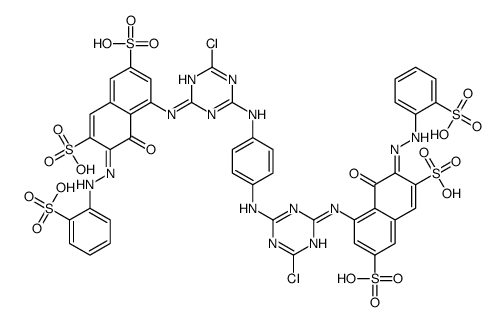reactive red 120

reactive red 120 structure
|
Common Name | reactive red 120 | ||
|---|---|---|---|---|
| CAS Number | 61951-82-4 | Molecular Weight | 1338.09000 | |
| Density | 2.01 g/cm3 | Boiling Point | N/A | |
| Molecular Formula | C44H30Cl2N14O20S6 | Melting Point | N/A | |
| MSDS | USA | Flash Point | N/A | |
| Symbol |

GHS08 |
Signal Word | Danger | |
|
Comparative analysis of bioremediation potential of adapted and non-adapted fungi on azo dye containing textile effluent.
Pak. J. Biol. Sci. 14(11) , 610-8, (2011) About 4 different predominant adapted fungal strains (screened from effluent sample) Aspergillus sp., Penicillium sp., Fusarium sp. and Mucor sp. and 4 predominant non-adapted strains (screened from soil, water and fungal fruiting bodies) Aspergillus sp., Pen... |
|
|
Effect of silk protein processing on drug delivery from silk films.
Macromol. Biosci. 13(3) , 311-20, (2013) Sericin removal from the core fibroin protein of silkworm silk is a critical first step in the use of silk for biomaterial-related applications, but degumming can affect silk biomaterial properties, including molecular weight, viscosity, diffusivity and degra... |
|
|
Ozonation of dyes and textile wastewater in a rotating packed bed.
J. Environ. Sci. Health. A. Tox. Hazard. Subst. Environ. Eng. 41(10) , 2299-310, (2006) This study investigates the ozonation of Reactive Red 120 and Acid Red 299 dyes in the synthesized solution and textile wastewater by using a rotating packed bed. The decomposition rate of Reactive Red 120 and Acid Red 299 dyes via ozonation can be described ... |
|
|
Degradation of reactive dyes in a photocatalytic circulating-bed biofilm reactor.
Biotechnol. Bioeng. 109(4) , 884-93, (2012) Decolorization and mineralization of reactive dyes by intimately coupled TiO₂-photocatalysis and biodegradation (ICPB) on a novel TiO₂-coated biofilm carrier were investigated in a photocatalytic circulating-bed biofilm reactor (PCBBR). Two typical reactive d... |
|
|
Purification of soluble adenylyl cyclase.
Meth. Enzymol. 345 , 95-105, (2002)
|
|
|
Purification of human malaria parasite hypoxanthine guanine xanthine phosphoribosyltransferase (HGXPRT) using immobilized Reactive Red 120.
Protein Expr. Purif. 52(1) , 153-8, (2007) Malaria is caused by Plasmodium parasite infection. The human malarial parasite does not have a de novo pathway for synthesis of nucleotides and the purine salvage pathway enzyme hypoxanthine guanine xanthine phosphoribosyltransferase (HGXPRT) is critical for... |
|
|
An insight into the influence of low dose irradiation pretreatment on the microbial decolouration and degradation of Reactive Red-120 dye.
Chemosphere 90(4) , 1348-58, (2013) The influence of low dose irradiation pretreatment on the microbial decolouration and degradation of Reactive Red-120 (RR-120) dye was investigated in detail by using Pseudomonas sp. SUK1. About 27%, 56% and 66% decolouration of 150 ppm RR-120 dye solution wa... |
|
|
Studies on photocatalytic activity of the synthesised TiO2 and Ag/TiO2 photocatalysts under UV and sunlight irradiations.
Water Sci. Technol. 63(3) , 377-84, (2011) Photocatalytic decolorisation and degradation of Reactive Red 120 (RR 120) has been investigated under UV (365 nm) and solar light as radiation sources using synthesised nano titania catalyst prepared via sol-gel method. The study encompassed calcination of s... |
|
|
Ozonation of the purified hydrolyzed azo dye Reactive Red 120 (CI).
J. Environ. Sci. Health. A. Tox. Hazard. Subst. Environ. Eng. 37(4) , 707-13, (2002) The combination of chemical and biological water treatment processes is a promising technique to reduce recalcitrant wastewater loads. The key to the efficiency of such a system is a better understanding of the mechanisms involved during the degradation proce... |
|
|
Removal of reactive dye using UV/TiO2 in circular type reactor.
J. Environ. Sci. Health. A. Tox. Hazard. Subst. Environ. Eng. 38(7) , 1389-99, (2003) Photocatalytic degradation of reactive dye, Red 120, was carried out on TiO2 particles as photocatalyst under UV irradiation. In this experiment, comparison on the removal of reactive dye by photolysis using UV light alone, photocatalyst adsorption using TiO2... |